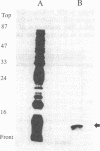Abstract
The glycosylation-inhibiting factor (GIF) was isolated from serum-free culture supernatants of the murine T-cell hybridoma, 231F1 cells, by using an immunosorbent coupled with the monoclonal anti-lipomodulin antibody. The isolated lymphokine is a 14-kDa protein with a pI of 5.5, as determined by SDS/PAGE and two-dimensional gel electrophoresis. Fractionation of a mixture of radiolabeled GIF with culture supernatant of the 231F1 cells on ion-exchange and reverse-phase columns and by gel filtration demonstrated homogeneity of the 14-kDa GIF and confirmed that the bioactivity of GIF and the antigenic determinant recognized by the monoclonal anti-GIF antibody are associated with the 14-kDa protein. The 125I-labeled 14-kDa protein binds to the murine T-cell hybridoma 12H5 cells, which have been used for bioassay of GIF, and the murine B-cell line A20.3 cells, but the binding of the protein to resting murine splenic lymphocytes was barely detectable. Under the same experimental conditions, binding of the 125I-labeled recombinant human lipocortin I to the 12H5 cells was not detectable. In contrast, the 125I-labeled lipocortin, but not the 14-kDa GIF, bound to phosphatidylserine vesicles. The results indicate that GIF does not belong to the anexin family.
Full text
PDF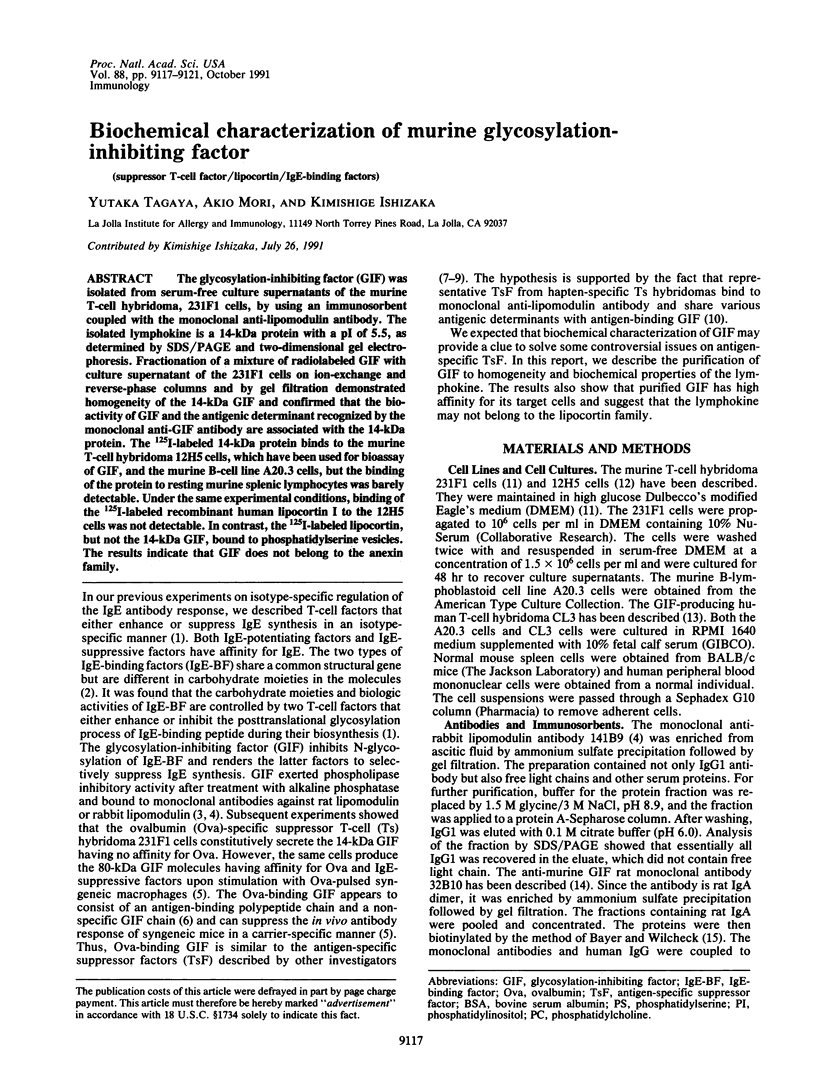
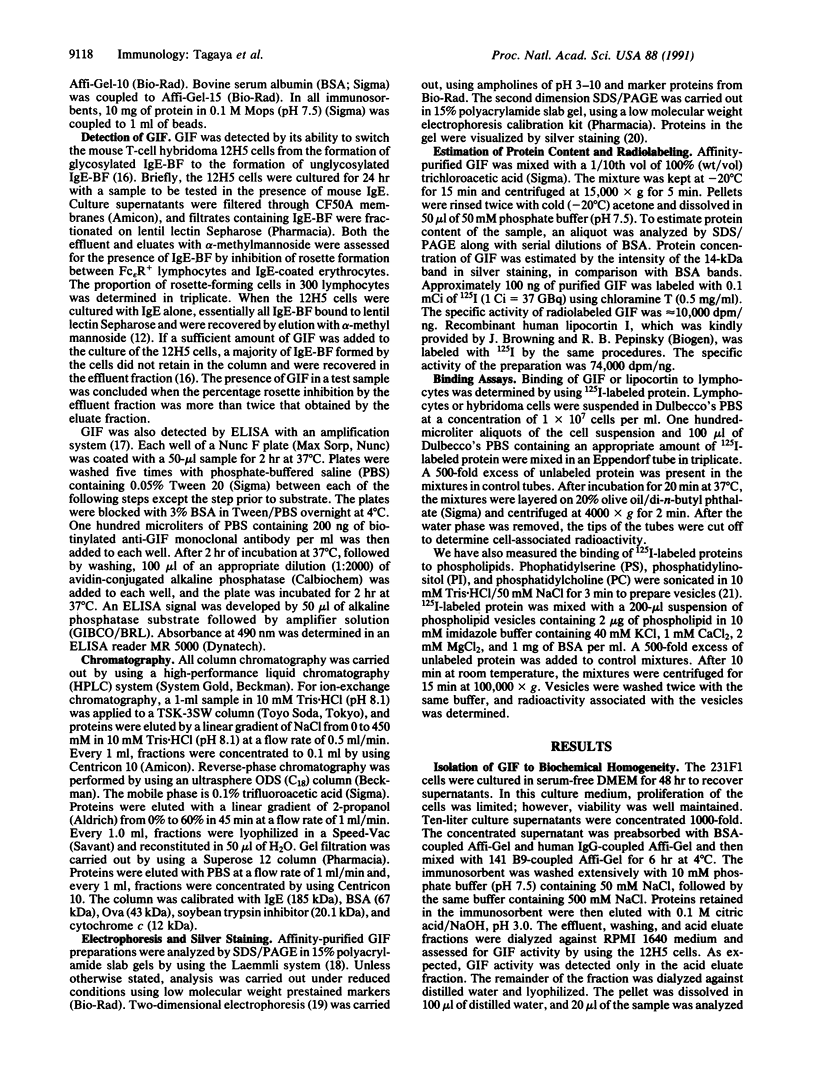
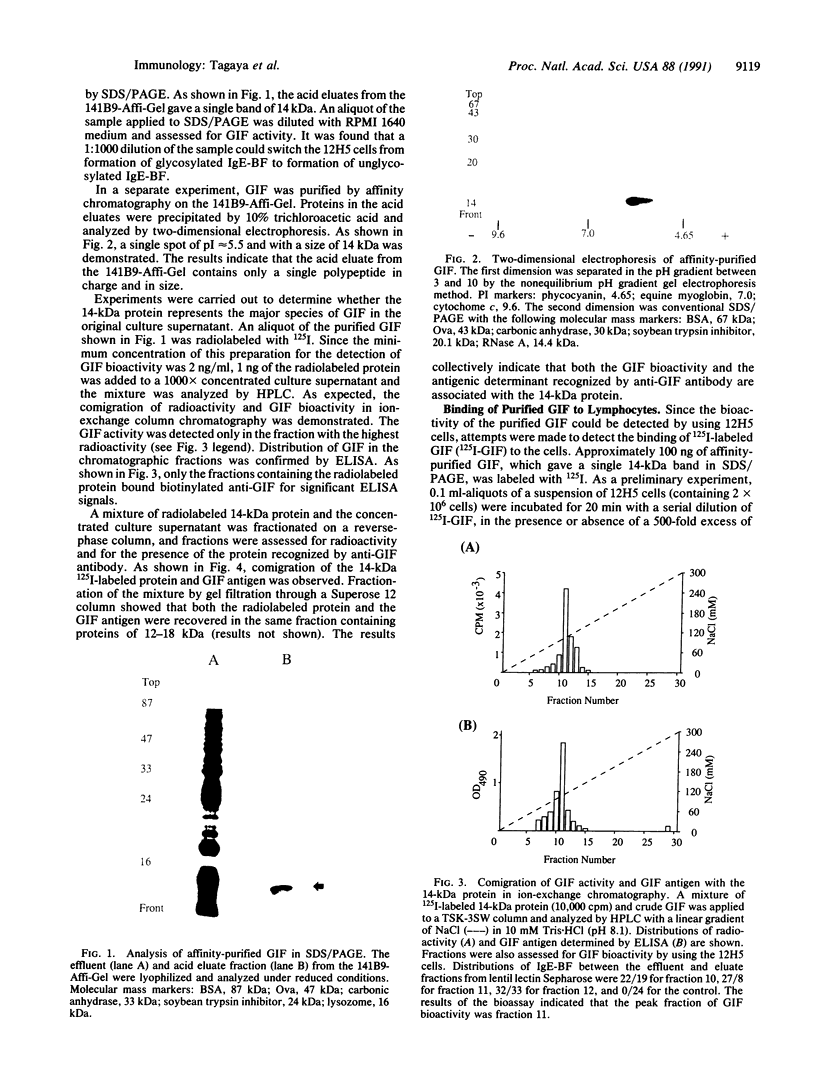
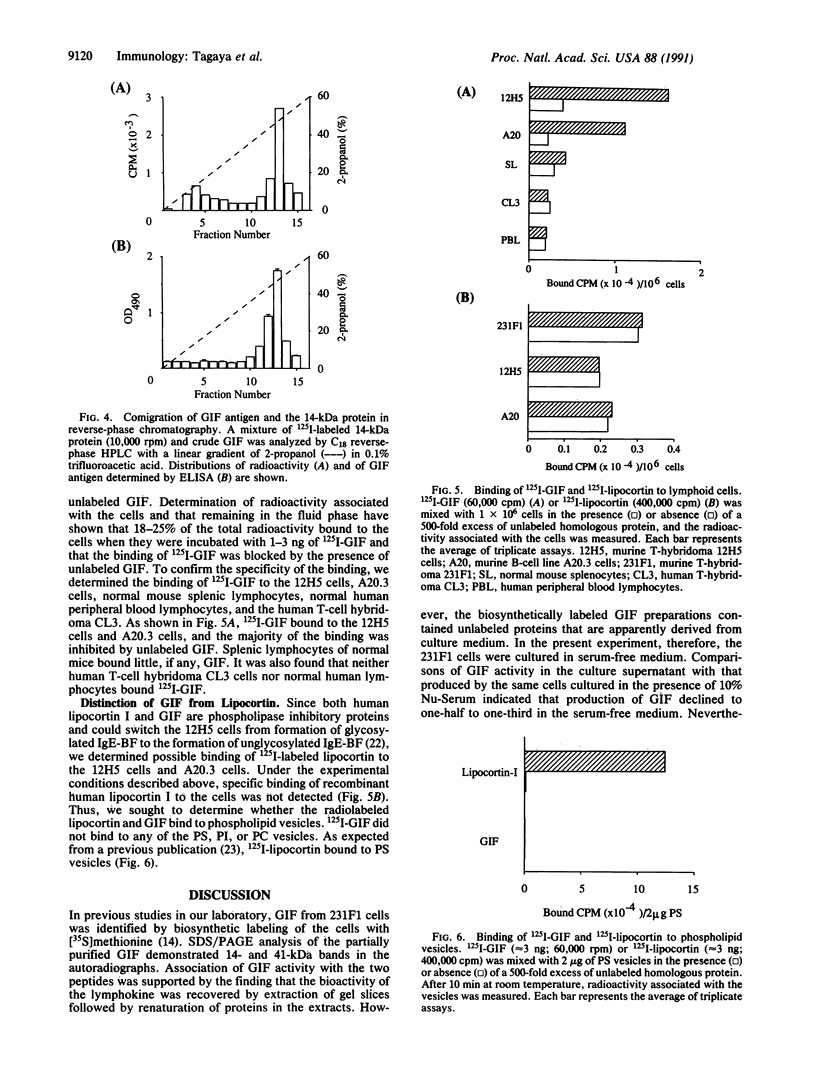
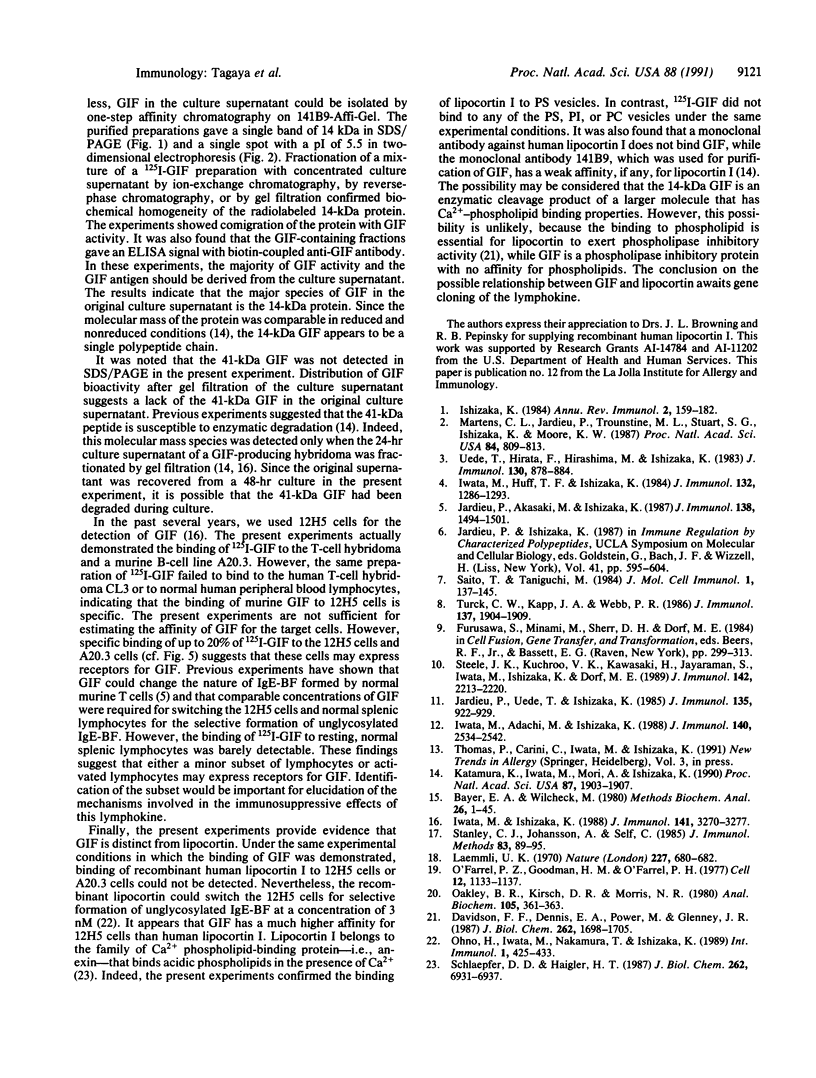
Images in this article
Selected References
These references are in PubMed. This may not be the complete list of references from this article.
- Bayer E. A., Wilchek M. The use of the avidin-biotin complex as a tool in molecular biology. Methods Biochem Anal. 1980;26:1–45. doi: 10.1002/9780470110461.ch1. [DOI] [PubMed] [Google Scholar]
- Davidson F. F., Dennis E. A., Powell M., Glenney J. R., Jr Inhibition of phospholipase A2 by "lipocortins" and calpactins. An effect of binding to substrate phospholipids. J Biol Chem. 1987 Feb 5;262(4):1698–1705. [PubMed] [Google Scholar]
- Ishizaka K. Regulation of IgE synthesis. Annu Rev Immunol. 1984;2:159–182. doi: 10.1146/annurev.iy.02.040184.001111. [DOI] [PubMed] [Google Scholar]
- Iwata M., Adachi M., Ishizaka K. Antigen-specific T cells that form IgE-potentiating factor, IgG-potentiating factor, and antigen-specific glycosylation-enhancing factor on antigenic stimulation. J Immunol. 1988 Apr 15;140(8):2534–2542. [PubMed] [Google Scholar]
- Iwata M., Huff T. F., Ishizaka K. Modulation of the biologic activities of IgE-binding factor. V. The role of glycosylation-enhancing factor and glycosylation-inhibiting factor in determining the nature of IgE-binding factors. J Immunol. 1984 Mar;132(3):1286–1293. [PubMed] [Google Scholar]
- Iwata M., Ishizaka K. Construction of antigen-specific suppressor T cell hybridomas from spleen cells of mice primed for the persistent IgE antibody formation. J Immunol. 1988 Nov 15;141(10):3270–3277. [PubMed] [Google Scholar]
- Jardieu P., Akasaki M., Ishizaka K. Carrier-specific suppression of antibody responses by antigen-specific glycosylation-inhibiting factors. J Immunol. 1987 Mar 1;138(5):1494–1501. [PubMed] [Google Scholar]
- Jardieu P., Uede T., Ishizaka K. Presence of an antigen-specific T cell subset that forms IgE-suppressive factor and IgG-suppressive factor on antigenic stimulation. J Immunol. 1985 Aug;135(2):922–929. [PubMed] [Google Scholar]
- Katamura K., Iwata M., Mori A., Ishizaka K. Biochemical identification of glycosylation inhibiting factor. Proc Natl Acad Sci U S A. 1990 Mar;87(5):1903–1907. doi: 10.1073/pnas.87.5.1903. [DOI] [PMC free article] [PubMed] [Google Scholar]
- Laemmli U. K. Cleavage of structural proteins during the assembly of the head of bacteriophage T4. Nature. 1970 Aug 15;227(5259):680–685. doi: 10.1038/227680a0. [DOI] [PubMed] [Google Scholar]
- Martens C. L., Jardieu P., Trounstine M. L., Stuart S. G., Ishizaka K., Moore K. W. Potentiating and suppressive IgE-binding factors are expressed by a single cloned gene. Proc Natl Acad Sci U S A. 1987 Feb;84(3):809–813. doi: 10.1073/pnas.84.3.809. [DOI] [PMC free article] [PubMed] [Google Scholar]
- O'Farrell P. Z., Goodman H. M., O'Farrell P. H. High resolution two-dimensional electrophoresis of basic as well as acidic proteins. Cell. 1977 Dec;12(4):1133–1141. doi: 10.1016/0092-8674(77)90176-3. [DOI] [PubMed] [Google Scholar]
- Oakley B. R., Kirsch D. R., Morris N. R. A simplified ultrasensitive silver stain for detecting proteins in polyacrylamide gels. Anal Biochem. 1980 Jul 1;105(2):361–363. doi: 10.1016/0003-2697(80)90470-4. [DOI] [PubMed] [Google Scholar]
- Ohno H., Iwata M., Nakamura T., Ishizaka K. Effect of phospholipase A2 inhibitors on mouse T lymphocytes. I. Phospholipase A2 inhibitors exert similar immunological activities as glycosylation inhibiting factor. Int Immunol. 1989;1(4):425–433. doi: 10.1093/intimm/1.4.425. [DOI] [PubMed] [Google Scholar]
- Saito T., Taniguchi M. Chemical features of an antigen-specific suppressor T cell factor composed of two polypeptide chains. J Mol Cell Immunol. 1984;1(3):137–145. [PubMed] [Google Scholar]
- Schlaepfer D. D., Haigler H. T. Characterization of Ca2+-dependent phospholipid binding and phosphorylation of lipocortin I. J Biol Chem. 1987 May 15;262(14):6931–6937. [PubMed] [Google Scholar]
- Stanley C. J., Johannsson A., Self C. H. Enzyme amplification can enhance both the speed and the sensitivity of immunoassays. J Immunol Methods. 1985 Oct 24;83(1):89–95. doi: 10.1016/0022-1759(85)90061-4. [DOI] [PubMed] [Google Scholar]
- Steele J. K., Kuchroo V. K., Kawasaki H., Jayaraman S., Iwata M., Ishizaka K., Dorf M. E. A monoclonal antibody raised to lipomodulin recognizes T suppressor factors in two independent hapten-specific suppressor networks. J Immunol. 1989 Apr 1;142(7):2213–2220. [PubMed] [Google Scholar]
- Turck C. W., Kapp J. A., Webb D. R. Structural analyses of a monoclonal heterodimeric suppressor factor specific for L-glutamic acid60-L-alanine30-L-tyrosine10. J Immunol. 1986 Sep 15;137(6):1904–1909. [PubMed] [Google Scholar]
- Uede T., Hirata F., Hirashima M., Ishizaka K. Modulation of the biologic activities of IgE-binding factors. I. Identification of glycosylation-inhibiting factor as a fragment of lipomodulin. J Immunol. 1983 Feb;130(2):878–884. [PubMed] [Google Scholar]




